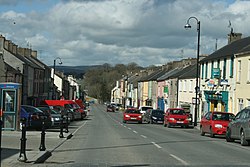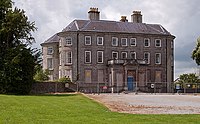Doneraile
| Doneraile Irish: Dún ar Aill | |
| County Cork | |
|---|---|
 Doneraile's main street | |
| Location | |
| Grid reference: | R601074 |
| Location: | 52°13’2"N, 8°35’5"W |
| Data | |
| Population: | 780 (2016) |
| Local Government | |
| Dáil constituency: |
Cork East |
Doneraile, historically Dunerayl, is a small town in County Cork, above the River Awbeg, a branch of the Blackwater. It is to be found on the R581 regional road, five miles east of the N20 road, which runs from Limerick to Cork, and about seven and a half miles north of Mallow town.
Name
The name of the place is the Irish Dún ar Aill, meaning 'Fort of the cliff'.[1] The town sits on the northern slope of Knockacur hill, which rises by a gentle slope from the Awbeg river and gradually ascends to a rocky prominence. However, it was not this rocky prominence but one near the graveyard of Oldcourt which together with an ancient fort built thereon, gave the town its name.[2]
History

The type of horse race known as the steeplechase originated in 1752 as a result of a race between the church steeples of the town and neighbouring Buttevant town.
There are only a few reported cases of women becoming Freemasons but one exception occurred in 18th century Doneraile. Elizabeth Aldworth, was reported to have surreptitiously viewed the secret proceedings of a Lodge meeting held at Doneraile Court — the private house of her father, Arthur St Leger, 1st Viscount Doneraile. Upon discovering the breach of their secrecy, the Lodge resolved to admit and obligate her, and thereafter she proudly appeared in public in Masonic clothing.
In 1829, the shooting of a local doctor, John Norcott, led to rumours of a widespread conspiracy to murder local landlords. On the word of an informer, twenty-one local men were arrested and charged with the alleged crime. Most were fortunate enough to be defended by Daniel O'Connell, who secured the acquittal of the majority of them. The event came to known as the Doneraile conspiracy.
Doneraile is also where Ireland's first successful agricultural co-operative and creamery was established in 1889 by Horace Plunkett.
During the early part of May 1853, a countryman ploughing in the neighbourhood turned up a large quantity of silver coins, amounting to more than forty-six ounces in weight, which were purchased by a silversmith in Cork. They consisted of English shillings and sixpences of Elizabeth, with a few groats, threepences and half-groats of the same queen; also a few groats of her predecessors, Mary, and Philip and Mary both having the bust of Mary; English shillings and sixpences of James 1, upon the union with Scotland and exclusively of the rose, thistle, and fleur-de-lis mint marks; with a large number of the quarter-dollars and smaller money of Ferdinand and Isabella of Spain. Nearly all the coins were in the finest state of preservation, and appeared to have been but little used or in circulation.
Doneraile also achieved note in 1954 when a British journalist, Honor Tracy, condemned the local priest Canon Maurice O'Connell for spending the then exorbitant amount of £9000 on his parochial house while there was so much poverty in the village. Following an apology to O'Connell by The Sunday Times, Tracy sued the paper and was awarded £3,000 in compensation. In response some 3,000 of Doneraile's parishioners marched in the village in support of the priest.
Outside links
| ("Wikimedia Commons" has material about Doneraile) |
References
- ↑ Placenames Database of Ireland
- ↑ Doneraile by J. Anthony Gaughan, Kamac 1970
